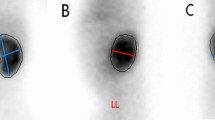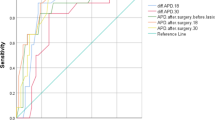Abstract
Infantile hydronephrosis detected by ultrasonography poses a clinical dilemma on how to treat the condition. This article reports a retrospective study to evaluate infantile hydronephrosis due to suspected ureteropelvic junction (UPJ) obstruction by means of standardized diuretic renography and to speculate its usefulness for quantitative assessment and management of this condition. Between November 1992 and July 1999, 43 patients who had the disease detected in their fetal or infantile period were submitted to this study. Standardized diuretic renograms were obtained with99mTc-labeled diethylene-triaminepenta-acetate (Tc-99m-DTPA) or99mTc-labeled mercaptoacetyl triglycine (Tc-99m-MAG3) as radiopharmaceuticals. Drainage half-time clearance (T 1/2) of the activity at each region of interest set to encompass the entire kidney and the dilated pelvis was used as an index of quantitative analysis of UPJ obstruction. Initial T 1/2s of 32 kidneys with suspected UPJ obstruction were significantly longer than those of 37 without obstruction. T 1/2s of kidneys which had undergone pyeloplasty decreased promptly after surgery whereas those of units followed up without surgery decreased more sluggishly. These findings demonstrate that a standardized diuretic renographic analysis with T 1/2 can reliably assess infantile hydronephrosis with UPJ obstruction and be helpful in making a decision on surgical intervention.
Similar content being viewed by others
References
Scott JE, Renwick M. Urological anomalies in the Northern Region Fetal Abnormality Survey.Arch Dis Child 1993; 68: 22–26.
Arger PH, Coleman BG, Mintz MC, Snyder HP, Camardese T, Arenson RL, et al. Routine fetal genitourinary tract screening.Radiology 1985; 156: 485–489.
Hirakawa H, Yokoyam S, Ueno S, Tajima T, Makuuchi H, Hamazaki Y, et al. Infantile abdominal ultrasound screening.Proceedings of 32nd Annul Meeting of Pacific Association of Pediatric Surgeons 1999:55
Tam JC, Hodson EM, Choong KK, Cass DT, Cohen RC, Gruenewald SM, et al. Postnatal diagnosis and outcome of urinary tract abnormalities detected by antenatal ultrasound.Med J Aust 1994; 160: 633–637.
Kitagawa H, Pringle KC, Stone P, Flower J, Murakami N, Robinson R. Postnatal follow-up of hydronephrosis detected by prenatal ultrasound: the natural history.Fetal Diagn Ther 1998; 13: 19–25.
Morin L, Cendron M, Crombleholme TM, Garmel SH, Klauber GT, D’Alton ME. Minimal hydronephrosis in the fetus: clinical significance and implications for management.J Urol 1996; 155: 2047–2049.
Terashima K, Nakaigawa N, Sano K, Asakura T. Long-term follow-up of mild hydronephrosis.J Jpn Soc Pediatr Surg 1995; 31: 748–753. (in Japanese)
Stocks A, Richards D, Frentzen B, Richard G. Correlation of prenatal renal pelvic anteroposterior diameter with outcome in infancy.J Urol 1996; 155: 1050–1052.
Cost GA, Merguerian PA, Cheerasarn SP, Shortliffe LM. Sonographic renal parenchymal and pelvicaliceal areas: new quantitative parameters for renal sonographic followup.J Urol 1996; 156: 725–729.
Whitaker RH. Methods of assessing obstruction in dilated ureters.Br J Urol 1973; 45: 15–22.
Thrall JH, Koff SA, Keyes JW Jr. Diuretic radionuclide renography and scintigraphy in the differential diagnosis of hydroureteronephrosis.Semin Nucl Med 1981; 11: 89–104.
Conway JJ, Maizels M. The “well tempered” diuretic renogram: a standard methods to examine the asymptomatic neonate with hydronephrosis or hydroureteronephrosis. A report from combined meetings of The Society for Fetal Urology and members of the Pediatric Nuclear Medicine Council—The Society of Nuclear Medicine.J Nucl Med 1992; 33: 2047–2051.
O’Reilly P, Aurell M, Britton K, Kletter K, Rosenthal L, Testa T. Consensus on diuresis renography for investigating the dilated upper urinary tract. Radionuclides in Nephrourology Group Consensus Committee on Diuretic Renography.J Nucl Med 1996; 37: 1872–1876.
Mandell GA, Cooper JA, Leonard JC, Majd M, Miller JH, Parisi MT. Procedure guideline for diuretic renography in children. Society of Nuclear Medicine.J Nucl Med 1997; 38: 1647–1650.
Arnold AJ, Rickwood AM. Natural history of pelviureteric obstruction detected by prenatal sonography.Br J Urol 1990; 65: 91–96.
Madden NP, Thomas DFM, Gordon AC, Arthur RJ, Irving HC, Smith SEW. Antenatally detected pelviureteric junction obstruction. Is non-operation safe?.Br J Urol 1991; 68: 305–310.
Author information
Authors and Affiliations
Rights and permissions
About this article
Cite this article
Ueno, S., Suzuki, Y., Murakami, T. et al. Quantitative analysis of infantile ureteropelvic junction obstruction by diuretic renography. Ann Nucl Med 15, 131–136 (2001). https://doi.org/10.1007/BF02988603
Received:
Accepted:
Issue Date:
DOI: https://doi.org/10.1007/BF02988603




